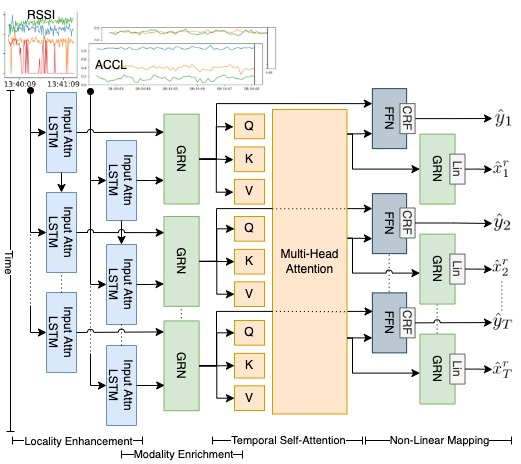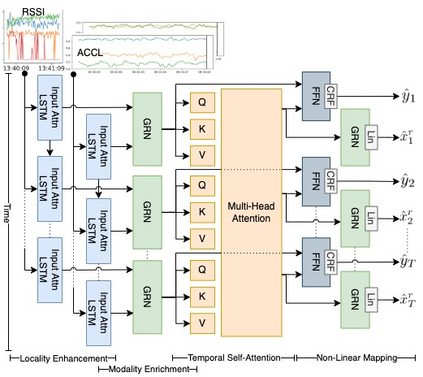Parkinson's disease (PD) is a slowly progressive debilitating neurodegenerative disease which is prominently characterised by motor symptoms. Indoor localisation, including number and speed of room to room transitions, provides a proxy outcome which represents mobility and could be used as a digital biomarker to quantify how mobility changes as this disease progresses. We use data collected from 10 people with Parkinson's, and 10 controls, each of whom lived for five days in a smart home with various sensors. In order to more effectively localise them indoors, we propose a transformer-based approach utilizing two data modalities, Received Signal Strength Indicator (RSSI) and accelerometer data from wearable devices, which provide complementary views of movement. Our approach makes asymmetric and dynamic correlations by a) learning temporal correlations at different scales and levels, and b) utilizing various gating mechanisms to select relevant features within modality and suppress unnecessary modalities. On a dataset with real patients, we demonstrate that our proposed method gives an average accuracy of 89.9%, outperforming competitors. We also show that our model is able to better predict in-home mobility for people with Parkinson's with an average offset of 1.13 seconds to ground truth.
翻译:Parkinson的疾病(PD)是一种缓慢进步的减弱性神经退化性疾病,主要特征是运动症状。室内定位,包括室间间转换的数量和速度,提供了代表流动性的代理结果,可以用作数字生物标志,以量化这种疾病发展过程中的流动性变化。我们使用从10个患有Parkinson的人群和10个控制器中收集的数据,他们每人在智能家中与各种传感器一起生活5天。为了更有效地在室内安放他们,我们建议采用基于变压器的方法,利用两种数据模式,即收到信号强度指标(RSSI)和来自可磨损装置的加速计数据,以提供运动的补充性观点。我们的方法通过在不同规模和级别学习时间相关性,使不对称和动态相关性成为一种数字标志;以及(b)利用各种定位机制在模式中选择相关特征,并抑制不必要的模式。在与实际病人一起建立的数据集中,我们建议的方法提供了平均89.9%的准确度,优于竞争者。我们还表明,我们的模型能够更好地预测人们在家中与公园inson的地面平均13秒之间的真实性。




